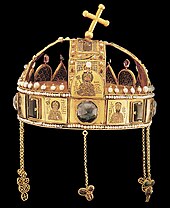
Back تاج المجر المقدس Arabic Карона Святога Іштвана Byelorussian Корона на свети Стефан Bulgarian Corona de Sant Esteve Catalan Uherská koruna Czech Ungarns krone Danish Stephanskrone German Corona de san Esteban Spanish Ungari Püha kroon Estonian تاج مقدس مجارستان Persian
| Holy Crown of Hungary | |
|---|---|
 Front of the Holy Crown | |
| Heraldic depictions | |
 | |
| Details | |
| Country | Hungary |
| Weight | 2,056 grams (72.5 oz) |
| Arches | 4 |

The Holy Crown of Hungary (Hungarian: Szent Korona [ˈsɛnt ˈkoronɒ],[note 1] Latin: Sacra Corona), also known as the Crown of Saint Stephen, named in honour of Saint Stephen I of Hungary, was the coronation crown used by the Kingdom of Hungary for most of its existence; kings were crowned with it since the twelfth century. The Crown symbolized the King's authority over the Lands of the Hungarian Crown (the Carpathian Basin), and it was a key mark of legitimacy. Through the history of Hungary, more than fifty kings were crowned with it, with the last being Charles IV in 1916. The only kings not so crowned were Wladyslaw I,[1] John Sigismund Zápolya, and Joseph II.
The enamels on the crown are mainly or entirely Byzantine work, presumed to have been made in Constantinople in the 1070s. The crown was presented by the Byzantine Emperor Michael VII Doukas to the King Géza I of Hungary; both are depicted and named in the Greek language on enamel plaques in the lower crown. However, in popular tradition the Holy Crown was thought to be older and of Papal provenance, dating to the time of the first King Stephen I of Hungary crowned 1000/1001. It is one of two known Byzantine crowns to survive, the other being the slightly earlier Monomachus Crown in the Hungarian National Museum,[2][3] which may have had another function. The Holy Crown has probably been remodelled using elements of different origins. The date assigned to the present configuration of the Holy Crown is most commonly put around the late 12th century.[4] The Hungarian coronation regalia consists of the Holy Crown, the sceptre, the orb, and the mantle. The orb has the coat of arms of Charles I (1310–1342).
The name "Holy Crown" was first used in 1256. By the 14th century it became the unique symbol of royal power. As written by Crown Guard Péter Révay, when Hungary needed a new monarch it did not seek a crown to inaugurate a king, but a king worthy of the Crown. He also said "the Holy Crown is for the Hungarians what the Lost Ark is for the Jewish people".[5]
Since 2000, the Holy Crown has been on display in the central Domed Hall of the Hungarian Parliament Building.
Cite error: There are <ref group=note> tags on this page, but the references will not show without a {{reflist|group=note}} template (see the help page).